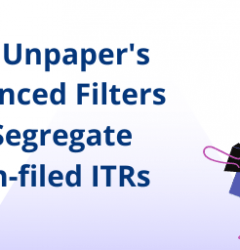
Tax Audit of an Individual Assessee – 15 Points to Consider
While conducting the tax audit of an individual assessee, a tax practitioner must take into consideration the below important check points.
1. Presumptive Taxation
- Ascertain if the assessee has opted for any presumptive Taxation Scheme as per sections 44AD, 44ADA, 44AE, 44B, 44BB, 44BBA, 44BBB, Chapter XII-G, First Schedule or any other relevant section. If yes, check the amount and the application of the relevant section.
- Verify if such profits and gains (as per scheme) have been included in the profit and loss account.
2. ICDS
- Ascertain the applicability of ICDS.
- Check whether the statement of adjustments required to profit or loss as per P&L in the tabular format given has been obtained.
- For a particular ICDS, if no adjustment is required, check whether the management representation in this regard has been obtained.
- Verify if the accounting policies followed by the assessee have been tested to see any divergence vis-a-vis ICDS.
- Confirm If disclosures as required by ICDS have been given in tabular form.
3. Valuation of Inventory
- Ascertain if the procedure followed by the assessee for the valuation of inventory of closing stock in respect of every item has been checked and verified (like raw material, WIP, finished goods, etc)
- Check if there has been any change in the method of valuation from the method as prescribed under section 145A
- Verify whether the adjustments in effect of difference between generally accepted accounting principles and section 145A has been made only in the statement of computation of total income accompanying the return and not been made in the books of accounts.
- Whether deviation, if any, from the method of valuation prescribed under section 145A has been ascertained and its impact on profit and loss has been reported.
- If adjustments under section 145A have been made in all cases where “exclusive method” is followed.
- If details of all capital assets converted into stock-in-trade has been obtained and checked.
- Check if the tax auditor has ascertained the correct date of acquisition from the records of the financial year in which the asset was acquired and stated the same in the report.
- Whether the original costs of acquisition as per books of account have been reported?.
- Whether the amount recorded in books of account in respect of the converted asset is stated in the Report.
- Confirm if the necessary accounting entries have been passed in the books of account at the time of conversion or treatment of capital asset into stock-in-trade.
4. Land or building transferred for a consideration less than value adopted or assessed or assessable by any authority of a State Government referred to in section 43CA or 50C
Confirm whether:
- the assessee has transferred any land or building or both during the year under consideration.
- the copy of registered sale deed has been obtained.
- the consideration shown in the registered sale deed is in accordance with the provisions of section 43CA or 50C.
5. Fixed Assets and Depreciation
- Obtain details of additions (purchases/ acquisitions) and deductions (sale, scrapping etc.) during the year
- Verify these details with records and documentary evidence such as supplier’s invoice, purchase order, sale bill etc.
- Obtain a certificate from technical person regarding the dates when assets acquired during the year were put to use
- Verify that cashless mode of payment is adopted where expenditure for acquisition of an asset involves payment of Rs. 10,000 or more to a person in a day
- Check whether the adjustments to the cost of fixed assets on account of changes in the rate of exchange of currency in the schedule of fixed assets prepared for computation of depreciation as per Income-tax Rules are in accordance with the provisions of section 43A
- Check whether a reconciliation statement has been prepared for any different treatment followed for difference of currency exchange for the purpose of books of account as per applicable accounting treatment under Accounting Standards
- Check whether bifurcation has been made and verified in respect of purchases made during of the year for a period of less than 180 days from the end of the financial year?
- Ensure that the classification of asset into Tangible and Intangible Assets and its addition to an appropriate block as per the rate of depreciation has been checked, verified, and made in consonance with legal principles
- Obtain suitable disclosure depending upon the facts and circumstances of the earlier disputes between the assessee and the Department regarding classification, rate of depreciation etc.
- Check whether the assessee company has opted for special taxation under section 115BAA during the AY 2020-21? If yes, calculate the adjusted WDV and report.
- Check the depreciation and additional depreciation (if any) calculated as per the Depreciation rates under the Income tax Act
6. Amounts debited to the profit and loss account, being in the nature of capital, personal, advertisement expenditure etc
- Check whether all expenditure heads of Trading/Manufacturing, P&L or I&E account (including purchase account) have been examined to check any Personal expense has been charged/ debited to it? If yes, report accordingly.
- Ensure all expenditure heads of P&L or I&E account has been examined to verify if any advertisement expenditure in any souvenir, brochure, tract, pamphlet or the like published by a political party has been charged/debited to it? If yes, report accordingly
- Ensure all expenditure heads of P&L or I&E account have been examined to verify if any expenditure is incurred at clubs being cost for entrance fees and subscriptions. If yes, report accordingly.
- Check whether all expenditure heads of P&L or I&E account has been examined to verify if any expenditure is incurred at clubs being cost for club services and facilities used? If yes, report accordingly.
- Check whether all expenditure heads of P&L or I&E account have been examined to verify if any expenditure by way of penalty or fine for violation of any law for the time being in force has been charged/debited to it? If yes, report accordingly.
- Check whether all the orders/notices received during the year under consideration under various laws like FEMA, GST, Custom and Excise etc. have been verified?
- Ensure that electronic cash ledger of GST Portal for payment of any fine or penalty has been verified
- Ensure that TDS returns/ Traces portal/ Form No. 26AS for any fine/penalty have been verified
- Ensure that all expenditure heads of P&L or I&E account have been examined to verify if any expenditure by way of any other penalty or fine not covered above has been charged/debited to them? If yes, report accordingly’
7. Amounts inadmissible under section 40(a)
- Whether any payment of interest, royalty and fee for technical services or any other sum chargeable under Income Tax Act, 1961 (other than salary) is paid/ payable outside India to any person or to non-resident/ foreign company in India.
- If yes, whether TDS has been deducted on said payments as per chapter XVII-B of Income Tax Act, 1961.
- Whether TDS deducted has been paid on said payments as per chapter XVII-B of Income Tax Act, 1961.
- Whether Form no. 15CA/15CB filed during the year has been obtained.
- Whether TDS challans and TDS returns in form no. 26Q and form no. 27Q has been obtained.
- Whether TDS payable account has been verified from the books of account and reconciled with TDS challans and returns.
8. Disallowance/deemed income under section 40A(3)
- Check whether there is any payment or aggregate payments for any expenditure to a person by mode otherwise than by account payee cheque or bank draft or through other such electronic mode in excess of Rs. 10,000 (or Rs. 35,000 in case of transportation), in a day.
- If yes, check whether such payments are falling under Rule 6DD.
- Check if such payments are not falling under rule 6DD, the same are not deductible and whether the same has been reported.
- Where the payments in excess of Rs. 10,000 (or Rs. 35,000 in case of transportation), has been made by account payee cheque or draft or through electronic mode, whether the same has been verified with available evidence.
- Where the reporting has been done on the basis of the certificate of the assessee, whether the fact has been reported as an observation in Form No. 3CA and Form No.3CB, as the case may be.
9. Recovery out of Bad Debts allowed earlier as a deduction
- Whether assessee has recovered any bad debt which was claimed as deduction in earlier years.
- Whether a statement of recovery of debts, which were earlier allowed as deduction, for write off as bad debts has been obtained.
10. Income chargeable under the head ‘income from other sources’ as referred to in section 56(2)(x)
- Check whether Assessee is in receipt of money other than from the relatives (as per section 56(2)) which exceeds Rs. 50,000.
- Check whether there is an addition to the immovable properties or investments (being immovable property) in the books of account. If so, check the mode of acquisition and consideration paid. Also, verify whether the same has been cross examined with SFT details in Form 26AS.
- Verify whether the mode of acquisition of the assets is provided in the exceptions such as will, gift from relatives, on occasion of marriage, from trust registered U/s 12A etc as mentioned in Fourth Proviso to Section 56(2)(x).
- Verify whether there is any addition to property being capital asset such as shares and securities, jewellery, archaeological collections, drawings, paintings, sculptures, any work of art or bullion present in the books of Accounts.
- Obtain the necessary agreement and sale deeds for verification
- Verify whether the assessee has disputed the stamp duty valuation and report accordingly.
- Ensure that the FMV valuation report as per Rule 11U/11UA been obtained in the case of other assets other than immovable property.
- Check whether the fair value of the amount chargeable to tax, if such money/property received is in excess of Rs 50,000 from the fair value has been computed.
11. Details of any amount borrowed on hundi or any amount due thereon (including interest on the amount borrowed) repaid, otherwise than through an account payee cheque. [Section 69D]
- Obtain complete list of borrowings on Hundi and its repayment (including interest) from the assessee.
- Check whether the loan balances confirmations has been obtained. Also check the bank book and bank statements.
- Verify whether the evidence of acceptance/repayment through an account payee cheque has been obtained.
- In the absence of conclusive or satisfactory evidence whether the auditor has obtained suitable certificate/representation in this regard.
12. Acceptance/Repayment of Loan/Deposit / Specified Sum under Sections 269SS and 269ST
- Check whether there is new acceptance/ repayment of any Loan/ deposit and transactions of specified sum during the year under consideration..
- Obtain the complete list of borrowings and repayments as envisaged under Sec.269SS and 269ST from the Assessee.
- Obtain Declaration from the Assessee in respect of sum exceeding the limit as specified in the above sections.
- Verify advance against property received or repaid during the year from the Fixed Assets or investments or stock in trade & Advance related ledgers.
- Check whether the assessee has received an amount of Rs2 Lakhs or more in aggregate from a person in a day or in respect of a single transaction or in regard to one event or occasion from a person in violation of the provisions of section 269ST.
- Check whether Loan confirmations from parties of Secured/ Unsecured loans, obtained or not.
13. TDS and TCS verification
- Check whether the assessee is required to deduct or collect tax as per the provisions of Chapter XVII-B or Chapter XVIIBB.
- Check from the various heads of expenses from the books of the assessee to ensure that wherever TDS was liable to be deducted, is deducted correctly.
- Verify the TDS/ TCS deduction/ collection with the relevant vouchers/challans / copy of accounts etc.
- Check instances where tax is deductible, but it is not deducted or there is short deduction/ not deposited.
- If there is any default in collection/ deposit whether the same have been checked in terms of section 40(a)(ia).
- In case of non- deduction/ nondeposit, check whether assessee has obtained Form 26A from the deductee.
- Check whether the TDS/TCS returns are filed within the due dates specified under the Act.
14. Interest under section 201(1A) or section 206C(7)
- Check whether the assessee is liable to pay interest under section 201(1A) or section 206C(7).
- If yes then, ask for the returns and challans and verify the interest calculation.
- If there is a difference in calculation vis-a-vis the amount reflected in Form. No. 26AS, check whether the observation and reason of difference have been reported accordingly.
15. Deemed Dividend under section 2(22)(e)
- Check whether the assessee has received any amount in the nature of dividend as referred to in section 2(22)(e).
- Check whether assessee has received any payment, by way of advance or loan from a company in which the assessee is a shareholder/ member/ partner having a substantial interest. Confirm if registered shareholder is having more than 10% shares in the said company.
- Check whether company possessed accumulated profits on the date of payment of such loan/ advance to the assessee and report accordingly.




Recent Comments